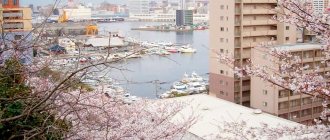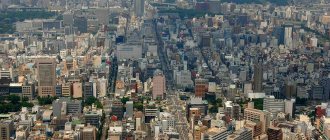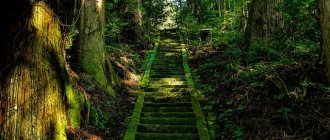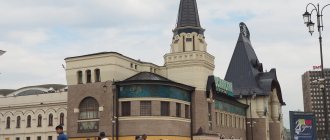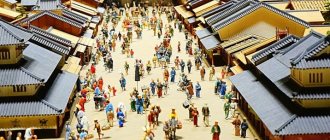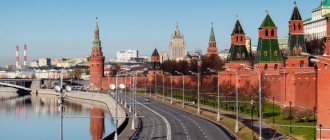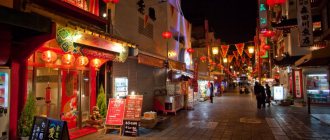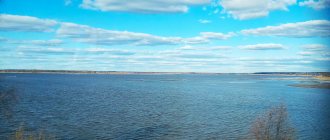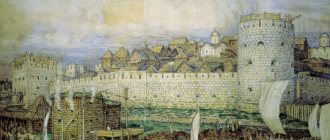| Central Tokyo. Dominants: Tokyo Skytree and Mount Fuji |
Tokyo
(東京[1]), the capital of Japan, the cathedral city of the Japanese Orthodox Church and its Tokyo Archdiocese. Located in the southeastern part of the island of Honshu, on the Kanto Plain, at the confluence of the Edogawa, Arakawa, Sumida and Tama rivers into Tokyo Bay of the Pacific Ocean. A hub for air and sea communications of international importance (Haneda and Narita airports, seaport); the country's main road and railway junction; extensive metro. The main economic, cultural and transport center of the country. Population - 9,128 thousand (July 1, 2014), the largest in the country. Together with the Tokyo metropolitan area (“Greater Tokyo”) and Yokohama, it forms the largest metropolis in the world by population.
- On the map: Yandex.Map, Google map
Edo
Japanese settlements on the vast territory of the modern city have existed since ancient times. The name Edo
(江戸, "entrance to the bay") is known no later than the 13th century, but the emergence of a significant settlement here dates back to the middle of the century, after Edo Castle was built in 1457. Settlements of artisans and traders soon arose around the castle, and the original castle town grew.
In 1590, the castle was taken over by Tokugawa Ieyasu, who, due to the strategic location of the city on the largest and most fertile Kanto plain in Japan, made Edo his residence. All subsequent Tokugawa shoguns until 1867 also ruled Japan from Edo. The central castle area was expanded and decorated starting in 1600, and palaces of appanage princes were built around the shogun's palace: from now on, the princes were forced to live with the shogun every six months, and the rest of the time to leave their families there as hostages. This concentration of nobility led to the very rapid and diversified development of the city. By the 18th century Edo (in Russian, through a distorted Western transcription - Ieddo
) became one of the largest cities in the world. At the same time, dense wooden buildings and frequent earthquakes were the causes of frequent fires. Among the most devastating disasters were the Great Fire of Meireki in 1657, which killed more than 100,000 people, and the earthquake of 1854.
Eastern capital of the empire
After the victory of reformers in the Boshin Civil War and the Meiji Restoration, shogunal rule was abolished, and the emperor and his government moved to Edo in 1868-1869, which was therefore renamed Tokyo
(東京, "Eastern Capital"). The shogun's castle complex became the imperial palace. At the same time, there was no official decree to move the imperial capital from Kyoto. The city quickly recovered from the shocks associated with the change of regime, and in the second half of the 19th century industry began to rapidly develop here - first silk, lacquer, earthenware and enamel, then mechanical engineering and shipbuilding. Printing, lithography and photography were highly developed. The Tokyo-Yokohama railway was built in 1872, and the Tokyo-Osaka-Kobe railway in 1877. Since 1877, Tokyo Imperial University has been operating - the first university in Japan, which subsequently invariably remained the largest. In 1894, the city experienced another strong earthquake.
In 1918, “rice riots” of workers took place in Tokyo, which broke out in connection with the end of the economic boom caused by the First World War, as well as under the influence of the October Revolution in Russia. On September 1, 1923, nearly half the city—which was still predominantly made of wood—was destroyed by the Great Kanto Earthquake and resulting fire, killing more than 90,000 people. Martial law was introduced and the city was rebuilt relatively quickly. In 1927, the first metro line opened its doors. The city rose again as a leading manufacturing center.
| Tokyo's Kanda district is in ruins. Photo 1945 |
During World War II, in 1944-1945, Tokyo suffered terribly again - during repeated bombings by American aircraft, a significant part of residential areas was destroyed.
Post-war Tokyo
In the post-war period, Tokyo, as before, quickly rebuilt itself and until the 1960s showed very significant rates of population growth in the wake of the Japanese “economic miracle”: by 1970, the population had almost tripled compared to 1945. In 1964, Tokyo hosted the 18th Olympic Games, which prompted significant reconstruction and the development of new urban centers. During the period of booming growth, the city was subject to severe air and water pollution, which was largely overcome by the end of the century. After the 1960s, the capital's population remained relatively stable, but growth resumed in the 2000s. Although Tokyo Metropolitan Prefecture remained one of the largest industrial areas in Japan, in the second half and early 21st century, the defining trend in the economic development of the capital was a decrease in the share of production functions and an increase in the role of management, trade, distribution and scientific information. The activities of the largest financial and industrial monopoly groups were concentrated in Tokyo. The capital also remained Japan's largest transport and tourism center. The city has largely retained its traditional cramped and chaotic layout without significant green areas, but has acquired a futuristic architectural appearance due to numerous skyscrapers and multi-level overpasses.
Statistics
- 1787 - 1,368 thousand people
- 1889 - 577 thousand people
- 1903 - 1,819 thousand people
- 1920 - 2,173 thousand people
- 1940 - 6,779 thousand people
- 1945 - 3,488 thousand people
- 1960 - 8,310 thousand people
- 1970 - 8,841 thousand people
- 1990 - 8,164 thousand people
- 2009 - in Tokyo Metropolitan Prefecture there are 2,868 registered Buddhist temples (22.29 per 100 thousand people, 45th place among Japanese prefectures) [2]; 1,467 registered Shinto idols (11.4 per 100 thousand people, 45th place among Japanese prefectures) [3]; 863 registered Christian churches (6.71 per 100 thousand people, 13th place among Japanese prefectures) [4]
- 2010 - 8,945 thousand people
| Tokyo's Asakusa district. Sensoji Temple and its shopping arcades. Photo by Kakidai May 19, 2012 |
Religion
Buddhism penetrated the boundaries of the present city in ancient times - tradition dates the establishment of the oldest Tokyo Buddhist temple, Sensooji (belonged to the Tendai sect until the second half of the 20th century), to 628. Ancient Japanese Shintoism was also invariably represented here - among the oldest idols still preserved today, Kanda myōjin, founded in 730, stands out. However, unlike the ancient imperial capital, Kyoto, in Tokyo the importance of Japan's largest pagan religious organizations could never rival the political importance of the city. The most notable temples in the capital, after ancient Sensoji, were the tomb temples of rulers and monument temples. Among the first, it is necessary to highlight the Shinto Meiji Jingu (1920), where the souls of Emperor Meiji and his wife are honored, as well as the Buddhist Zoojooji of the Jodo-shu sect, where six shoguns rested. The shrine-monuments include probably the country's most famous and controversial Shinto shrine, the Yasukuni Jinja (1869), which has honored the souls of all those who died in the war in the service of Japan since 1868. Also notable is the Buddhist Ekoin, the burial site of thousands of victims of the Great Meireki Fire of 1657. Due to frequent and severe destruction, only a few of Tokyo's temples preserved historical buildings for a long time - the rare temple that survived all the upheavals of the century in its original form was Gokokuji of the Shingon sect. Overall, the influence of Buddhism and Shinto in Tokyo remained relatively weak and at the beginning of the 21st century, Tokyo Metropolitan Prefecture had one of the lowest ratios of Buddhist and Shinto shrines to population in the country.
The flip side of the weakness of the most widespread religions - Buddhism and Shinto - was the relative importance of other religious movements. Confucianism, which had a prominent influence in Japan during the Tokugawa period, was represented in Edo by the Yushima Seidō Shrine, probably the most important Confucian shrine in the country. Since the end of the Tokugawa period, syncretic “new religions” have become a prominent phenomenon in the religious life of Japan, especially strong in the metropolitan metropolis. A huge number of different sects made Tokyo the center of their operations. A significant event that emphasized the danger of the proliferation of radical “new religions” was the gas attack carried out by the apocalyptic sect Aum Shinrikyo in the Tokyo subway in 1995, during which 12 people were killed and several thousand were poisoned.
The short-term appearance of Roman Catholics in the city in the 16th-17th centuries was brutally suppressed in the capital as well as throughout the country - mass executions of Roman Catholics began in Edo in April 1612 [5]. Christianity began to spread again from the middle of the 19th century and soon took an important place in the religious life of the capital. Most of the newly founded Christian organizations in Japan set up their headquarters in the new capital as soon as possible and devoted much effort to preaching in Tokyo. The independent Tokyo dioceses were founded by Roman Catholics in 1891 [6]; Orthodox in 1906, Anglicans in 1923 [7]; Various Protestant movements are represented in large numbers. Among the most famous Christian institutions in the country are Tokyo universities: Sofia (founded by the Jesuits), Rikkyo (founded by the Anglicans), International Christian University. One of the earliest and most famous large Christian cathedrals in Japan was the Orthodox Tokyo Resurrection Cathedral (“Nikorai-do”), completed in 1891. Overall, at the beginning of the 21st century, Tokyo Metropolitan Prefecture was one of the third most Christianized regions of Japan in terms of the ratio of Christian churches to population.
| Tokyo's Ochanomizu district. In the center is the Orthodox Tokyo Resurrection Cathedral (Nikorai-do). Photo from the website toyota-rus.narod.ru |
Tokyo before and during the Edo period[ | ]
Tombs of the 47 Ronin at Sengakuji Temple.
The Edo period began in 1603, when Tokugawa Ieyasu became shogun.[2] Tokyo was then a fishing village. In the 12th century, local Edo warrior Tara Shigenada built a fort here. The original name of Tokyo was Edo (until 1869). According to tradition, the name Edo (Japanese 江戸lit. “entrance to the bay”
) he received at his place of residence. In 1457, Otto Dokan (Japanese: 太田道灌), ruler of the Kanto region under the Japanese shogun, began construction of Edo Castle (Japanese: 江戸城).
By order of Uesugi Mochitomo, construction of a castle began in the place where the East Garden of the Imperial Palace is currently located.[3] In 1524, Hodyō Uditsuna entered the castle. In 1590, Ieyasu Tokugawa, the founder of the shogun clan, took possession of it. In 1603, he made the city the seat of the shogunate; the imperial capital remained the city of Kyoto (the cities of Tokyo and Kyoto are connected by the oldest land road of Japan - Tokaido). Thus began the Edo era (Japanese: 江戸時代), or the Tokugawa era (Japanese: 徳川時代) in the history of Japan. Edo began to grow rapidly and by the 18th century became one of the largest cities in the world. In 1615, Ieyasu destroyed his opponents, the Toyotomi clan, thereby gaining absolute power for about 250 years.
In 1637, construction of the castle, including the main tower, was completed. In 1657, the “Great Fire of Edo” began, which destroyed the castle and most of the red light district of the Asakusa district (Japanese: 浅草). 100,000 people died.
In 1707, the Fuji volcano awakens and ash covers the city.
In 1721, Edo became the largest city in the world with a population of 1.1 million.[4] Edo's growth was caused in part by the Great Meireki Fire of 1772, which killed approximately 6,000 people.[5]
In 1855, the “Great Earthquake” occurred, which caused significant damage[6].
Orthodoxy in Tokyo
In 1871, at the direction of Equal-to-the-Apostles Nicholas of Japan, his first Japanese convert, Pavel Sawabe, visited Tokyo and assessed the situation in the capital as very favorable for the beginning of the preaching of Orthodoxy. The following year, Saint Nicholas himself moved to Tokyo and began to establish a new headquarters for the Japanese Mission on Surugadai Hill. Soon the first Orthodox church in the capital, the Nativity of the Cross Church, and the first Orthodox school, transformed into a theological seminary in 1875, were opened here. Equal to the Apostles Nicholas paid great attention to preaching in the new capital - houses for preaching were set up in different parts of the city, around which the first communities of believers quickly began to grow. In 1884-1891, with funds donated from Russia, the Tokyo Resurrection Cathedral (in Japanese usage - “Nikorai-do”) was erected on the mission site, which became a symbol of Orthodoxy not only in the capital, but also in Japan. From 1906, the nascent Japanese Orthodox Church was organized as the Tokyo Diocese with a see at the Cathedral of the Resurrection. Moreover, during the years of the sainthood of Nicholas of Japan, the leading Tokyo parishes could compare with the cathedral in both numbers and liveliness. At the peak of missionary activity in Tokyo, there were more than a dozen Orthodox communities - for example, in 1911 there were a cathedral parish, an Ascension parish in Kanda, an Epiphany parish in Koojimachi, a Trinity parish in Shitaya, a Transfiguration parish in Asakusa, a Peter and Paul parish in Honjo, a parish in Hongoo, parish in Kyobashi-Nihonbashi, parish in Shinagawa, parish in Fukagawa, parish in Hori-no-Uchi-Ooji, parish in Senju-Mikawajima [8].
The turmoil experienced by the Japanese Church in the century - the cessation of aid from Russia after the October Revolution, the Great Kanto earthquake that destroyed half the city and severely damaged the cathedral in 1923, the bombing of World War II, the politicized unrest during the Cold War - led to the collapse of missionary activity and the gradual disappearance of the majority of Tokyo parishes After World War II, only two Orthodox churches survived in the capital - the Resurrection Cathedral and St. Nicholas Church on the cathedral site, so the lives of all Orthodox Christians in the city were concentrated here. The only historical parish that was able to restore its own temple was the Koodimachi-Yotsuya parish, which since 1954 has settled at the new temple in Yamate. The remaining old Japanese Orthodox communities of the capital, one after another, were merged into a single parish of the Resurrection Cathedral - a process that was completed under Metropolitan Feodosius of Tokyo. At the same time, the parishioners of the Japanese Patriarchal Deanery formed after the war (since 1970 - the Patriarchal Metochion), which largely consisted of Russians, maintained a separate liturgical life in the St. Nicholas House Church.
The revival and strengthening of the Russian Orthodox Church since the end of the century, as well as the wave of emigration from the countries of the former USSR after its collapse, were reflected in church life and in Tokyo. In particular, in 2005, the foundation was laid for the St. Nicholas Monastery on the cathedral site, and in 2008, the Japanese metochion of the Russian Church rebuilt a new Alexander Nevsky Church in Meguro.
The Saints
- Equal. Nikolai (Kasatkin) (+ 1912) - educator of Japan, archbishop. Tokyo
Monasteries
- Nicholas of Japan (male)
Temples
- Alexander Nevsky in Meguro at the metochion of the Russian Orthodox Church
- Epiphany in Yotsuya (destroyed in 1945, replaced by the Nativity Temple in Yamate)
- Resurrection of Christ, Cathedral
- Nicholas of Myra, brownie, at the metochion of the Russian Orthodox Church
- Nicholas of Myra, “small temple” (dismantled in 1962)
- Nicholas of Japan, chapel (adapted for the temple of the St. Nicholas Monastery)
- "Nikorai-do" (see Tokyo Resurrection Cathedral)
- Nativity of Christ, cross (dismantled in the early 1880s, replaced by the Resurrection Cathedral)
- Nativity of Christ in Yamate
- Epiphany of the Lord in Koojimachi (dismantled c. 1911, replaced by the Nativity Church in Yamate)
- Church at the Russian Embassy (abolished in the 1920s)
Educational establishments
- Tokyo Theological Seminary
- Tokyo Catechetical School (inactive)
- Tokyo Girls' School (inactive)
Showa era[ | ]
On an 1888 map, the Meyers Konversations-Lexikon encyclopedia shows the old German names for Tokyo and Edo: Tokio and Jedo, respectively.
The Showa era, 1926–1989, began in a depressed mood. Nevertheless, the first subway line (Ginza Line) was launched between Asakusa (浅草) and Ueno (上野) in 1927, and in 1928 the first general elections to the House of Representatives of the Diet took place. In 1931, Haneda Airport (Tokyo International Airport) was built. In 1941, the Port of Tokyo was opened. By 1935, the city's population had reached 6.36 million, comparable to the populations of New York and London.
In 1936, during an attempted coup d'état, approximately 1,500 junior officers and the Japanese Army occupied the National Diet building, the Kantei Prime Minister's residence, and other key locations. The coup was crushed by the army and navy within three days.
Bombed areas of Tokyo. Photo from 1945
The city again suffered heavy losses during World War II. Tokyo was subjected to massive air attacks (it was bombed 102 times. In one B-29 raid alone, more than 100,000 residents were killed. Many wooden buildings burned down, the Imperial Palace was damaged. The heaviest air raid was on March 10, 1945, which resulted in large casualties among the population and destruction of urban structures. In 1943, the dual system of Tokyo Prefecture and Tokyo City was abolished, and the prefecture and city were united, creating the capital of Tokyo. A metropolitan administrative system was established and a governor was appointed. After the war, the population was 3.49 million in October 1945 , which was half its level in 1940. The losses that Tokyo suffered in the war are like the two atomic bombs dropped on Hiroshima and Nagasaki combined.
Tokyo Tower was built in 1958. It was built from recycled military tanks.
Since September 1945, the city has been under military occupation and regulated by Allied forces. General Douglas MacArthur established his headquarters in Tower DN-21 (formerly the Dai-Ichi Seimei Building) overlooking the Imperial Palace. There are currently several US military bases in Japan.
On July 1, 1943, the city of Tokyo was abolished. The Tokyo Metropolitan Region was formed from the former city of Tokyo and Tokyo Prefecture, and the Governor of Tokyo became a member of the Cabinet, reporting directly to the Prime Minister.
In May 1947, Japan's new Constitution and Local Autonomy Law came into force, and Seichira Yasui was elected as the first governor of Tokyo under a new vote-counting system. In August of this year, the area of 23 special districts in Tokyo was organized.
In the mid-20th century (beginning in the 1950s), the country's economy began a rapid recovery (what has been described as an "Economic Miracle") and in 1966 it became the second largest economy in the world. Television and radio broadcasting began in 1953. In 1954, a second subway line (Marunouchi Line) was launched between Ikebukuro and Okachimachi. Japan joined the United Nations in 1956. Thanks to technological innovations and the introduction of new industries and technologies, this period saw the beginning of mass production of synthetic fibers and family electrical household appliances such as televisions, refrigerators and washing machines. In 1962, Tokyo's population exceeded 10 million.
On October 10, 1964, the Summer Olympic Games were held in Tokyo, where the city showed itself favorably on the international stage. That same year, 10 days before the games, the Tokaido Shinkansen (“bullet train”) line was launched on October 1, and the Metropolitan Express was inaugurated, setting the stage for Tokyo's future prosperity.
Since the 70s, Tokyo has been overwhelmed by a wave of labor from rural areas, which led to further development of the city. But at the same time, environmental problems began to make themselves felt: air and water pollution, high noise levels. The oil crisis of 1973 contributed to the stalling of the city's economic development.
In 1978, the New Tokyo International Airport, or Narita Airport, opened in neighboring Chiba Prefecture. Haneda Airport began serving primarily domestic flights.
In the 1980s, Tokyo became one of the largest metropolitan areas in the world, while on the other hand, problems such as environmental degradation, traffic jams and insufficient disaster preparedness began to grow.
Heisei era[ | ]
The new Tokyo Government Building was built in 1991 in Shinjuku, Tokyo.
Since 1986, land and stock prices have skyrocketed (the bubble effect). In 1990, Japan benefited greatly from this, but then the bubble burst, and tax revenues depreciated due to a sharp drop in prices over a long period, which led to a critical state in the capital's finance environment. The 1990s in Japan are called the “lost decade” (Japanese: 失われた10年ushinawareta ju:nen
).
On March 20, 1995, a sarin gas attack occurred in the Tokyo subway. The attack was carried out by the non-religious organization Aum Shinrikyo. As a result, 5,000 people were injured, 11 of them died[7].
In 1999, Shintaro Ishihara was elected as the new governor of Tokyo[8]. In 2003, he was re-elected to a second term.
Seismic activity in the Tokyo area has led to discussions about moving the capital of Japan to another city. Three candidates have been named: Nasu (300 km north), Higashine (near Nagano, central Japan) and a new city in Mie province, near Nagoya 450 km west of Tokyo). The government's decision has already been received, although no further action has yet been taken.
In 2008, an application was submitted to the IOC for the right to host the Olympic Games in Tokyo in 2021. The Fukutoshin line begins operation. The length of the metro network is almost 400 km.
In 2011, construction was completed on the Tokyo Sky Tree, Japan's tallest building (634 m tall, displacing the CN Tower in Toronto as the tallest free-standing building in the world).
Currently, Tokyo continues to develop. Projects to create artificial islands are being consistently implemented. The most notable project is Odaiba (Japanese: お台場), which now serves as a major shopping and entertainment center.
Notes[ | ]
- Nussbaum, Louis Frederic. (2005). "Tokyo" in Japan Encyclopedia , pp. 981-982
in Google Books;
"Kanto" on page 479
in Google Books - Nussbaum, " Edo Jidai
" at
page 409
in Google Books - Naito, Akira. "From Old Edo to Modern Tokyo: 400 Years," Nipponia.
No. June 25, 15, 2003; - International press center. (1997). Japan: Eyes on the Country, Views of the 47 Prefectures, p. 127.
- Iwao, Seiichi et al. (2002). Historical Dictionary of Japan, page 507.
- Smitts, Gregory. "Shaking up Japan: Edo Society and the 1855 Catfish Picture Prints", Journal of Social History
, No. 39, 4, Summer 2006. - Hongo, Jun, “Last trial brings dark Aum era to end” // Japan Times, 22 November 2011
- Zubov N.
O brave new mayor
(unspecified)
. Kommersant Power (October 30, 2001).
